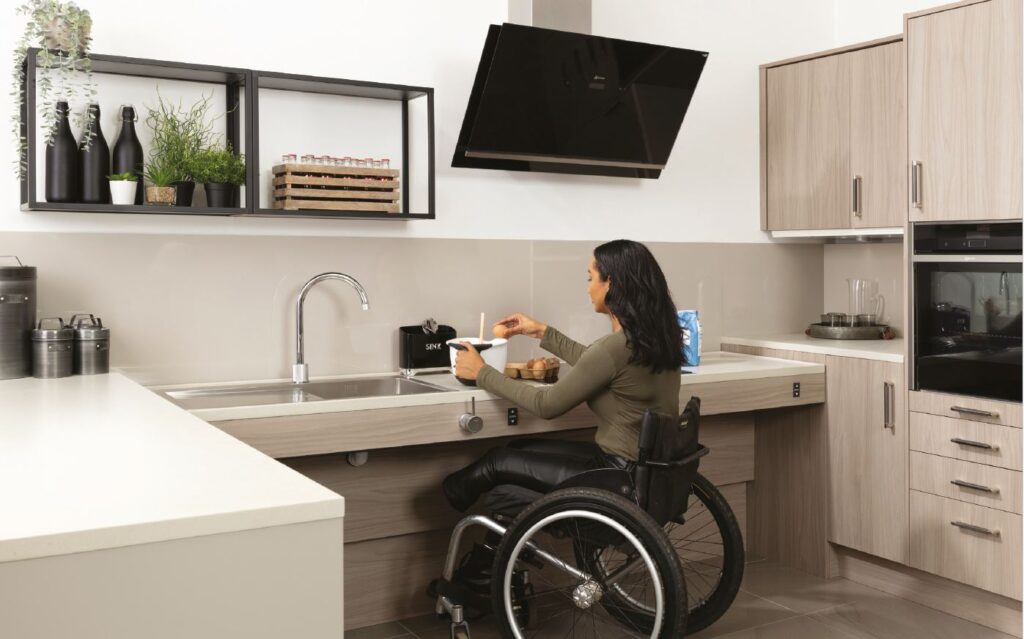Accessible kitchen design
The kitchen is often described as the heart of the home, so ensuring it is completely accessible to a person’s needs is of vital importance.

We spoke to some of the leading experts on accessible kitchen design to bring you some insight into the advancements that have been made in this area.
We hear from Mark Sadler from Ropox, a leading manufacturer of accessible kitchen solutions, Robert Newton from Symphony, one of the UK’s leading kitchen manufacturers including the Freedom brand of accessible kitchens, and Adam Thomas who is an independent design consultant, acknowledged as a world leader in accessible, multigenerational, and inclusive kitchen design.
Universal multi-generational accessible kitchens
In the UK, one in five working people are currently living with a disability and they have a combined spending power of £274 billion. Compared to 40 years ago, the technology vailable today is groundbreaking, and all accessible kitchens in new build homes must adhere to the 2016 Doc-M Building Regulations to ensure they meet the necessary safety standards. In addition to the Doc-M regulations, The Wheelchair Housing Design Guide (third edition) from Habinteg is another great source of information for accessible kitchen designers, anufacturers and OTs working in this field. With approximately 14.1 million disabled people in the UK and nine million living in a multi-generational household, plus an aging population with one in five people being 65 years and over – the Freedom kitchen brand from Symphony combined with the rise and fall height adjustable worktops from Ropox cater to a huge demand for kitchens that are uncompromised in both style and functionality and that can be used easily by every member of the family. These numbers are going to continue to increase over the coming years as our population continues to age and live longer, so as a society we need to be enabling people to live independently in their own homes for as long as possible. Building regulations have certainly helped shape the design of accessible homes and in turn wheelchair accessible kitchens. Back in 1981 when Adam became a wheelchair user following a motorbike accident there were only two kitchen manufacturers that made any claim to be accessible and no retail accessible kitchen market. Sadly, retailers, designers and larger manufacturers did not see the financial potential of the disabled market back then. Thankfully things have changed. These days some of the largest kitchen manufacturers are investing heavily in designing universal multi-generational accessible kitchens and associated equipment and Freedom by Symphony and Ropox have been at the forefront of this.
While it is great that companies like this are investing, unfortunately, many designers haven’t had any specialist training and here fore do not fully understand the ergonomics of accessible kitchens. If you adhere to the rules outlined in Doc-M the majority of disabled people will be able use the accessible kitchen and therefore cook for themselves. It is vital to know when to recommend certain products. For example, Adam has lost count of how many times he has seen someone turned down for a rise and fall worktop who have multiple sclerosis but are still ambulant. Many people with MS may initially use a perching stool therefore a rise and fall worktop is ideal for them and as their condition progresses and they become reliant on a wheelchair, the kitchen will still be suitable for them. It is all about future proofing the kitchen. Being involved in the initial planning stage of a new build or building conversion is something Adam, Rob and Mark all feels should be addressed. It can make a huge difference if you can see the plans before any work is undertaken to ensure the kitchen area will be big enough to accommodate an accessible kitchen. For example, in Doc-M it states that in a one-bed, two-person apartment the minimum worktop length should be 6130 mm, however if you measure the three walls (if open plan) or two walls (if an L-shape) you might just have enough worktop length. However, if you then factor in installing an oven, a fridge freezer and larder storage at the correct height you can’t get the 6130 mm worktop space required. Door, window, and boiler positioning is crucial, often if a door was moved by just 300 mm one way or the other, the client and OT could have the worktop and kitchen they really need instead of having to compromise. Furthermore, based on the regulations, 6-8 bed space houses should have 8530 mm plus of worktop which is a huge kitchen. Over the years, accessible kitchens have gone from one extreme when there were no minimum requirements, to these fantastic lengths to achieve, but the problem is the house designers, architects and builders still aren’t designing properties big enough to comply with Doc-M so when it comes to the kitchen the design is nearly always compromised. It may sound obvious, but when designing a property,31
extension or changes to an existing building, think about where you are going to put doors, windows, and the boiler (if applicable), as often plans mean that the only place to put a right angle rise and fall worktop is underneath the boiler which is something that should be avoided for safety reasons. Moving the boiler or window position at the plan stage is clearly much easier than at the kitchen design stage. The design team are then left struggling as a right angle rise and fall worktop as opposed to straight run is always the favoured option and works much better for the client as they can move things from the hob to the sink without having to move far, and this also complies with Doc-M.
THE FUTURE OF ACCESSIBLE KITCHENS
Looking ahead, Adam, Mark and Rob all believe the future of accessible kitchens is very exciting with assistive technology being at the forefront of many new developments. For example, NEFF recently announced plans for a range of voice-activated ovens, ensuring a client who has lost movement in their hands will still be able to turn the oven on, set the temperature and the timer. The NEFF system is linked via their HomeConnect technology to NEFF head office so any technical issues can be assessed remotely to ensure when an engineer comes out, they have already diagnosed the problem and have the necessary parts if required to resolve the issue. For additional safety the oven can also be controlled via the HomeConnect app, allowing a relative to check when the oven was last turned on, and if they are concerned if it has been left on, they can turn it off remotely.
KITCHENS IN ACTION
Barking and Dagenham College is a fantastic example of where Mark, Rob and Adam combined to design and supply a bespoke accessible kitchen which houses four individual workstations. The installation was managed by a Reading-based retailer of Freedom kitchens, Tara Neil Kitchens and Bedrooms. The kitchen features four Ropox electric rise and fall worktop systems which have been integrated into Symphony’s popular Urban Indigo range with a white work surface. Each worktop has a shallow bowl sink with a heat resistant base, so they are safe and easy to use for wheelchair users whilst the waterfall edge on the worktop helps prevent spills and enables people to grip the edge of the worktop for stability if needs be. Three of the stations have a traditional tap design with a fourth having a front access tap system to further assist students using a wheelchair, the finishing touch to each station is an induction hob which ensures there is no danger of students burning themselves. Each NEFF ‘slide and hide’ oven has been positioned at a safe and accessible height to ensure all students can use them while the issue of storage has been addressed with tall pantry units that have internal drawers for plenty of pull-out storage. “Prior to this investment we had very few resources in terms of an accessible kitchen, especially for our wheelchair users. For example, the staff would have to help with mixing ingredients if they couldn’t reach the worktop and when it came to using the oven, staff often had to take over. Washing up was another challenging task, especially for our wheelchair users as we would have to place a bowl of water in their lap which would result in water going everywhere. However, now everything has changed thanks to our fantastic new kitchen,” commented curriculum manager Lisa Talbot. The students love the new kitchen, as do the staff as lecturer Laura explains: “The kitchen is just amazing! Prior to installation, the students required a lot of support to complete tasks which they could have done independently if we’d had the correct adaptive equipment. But now the students can do so much more for themselves without me or any other staff members having to help, which is fantastic for their learning and confidence. The rise and fall worktops are a real game changer for us as now every student, regardless of whether they are a wheelchair user or not can easily set the worktop to their ideal working height. That is another great feature of the kitchen, from the worktops and taps to the hobs and oven, everything is incredibly user-friendly.”
For more information on the full range of products available from Ropox, or to book an assessment, contact Mark on ms@ropox.com or 07444 577609.
Article from the OT Magazine, March/April 2022





